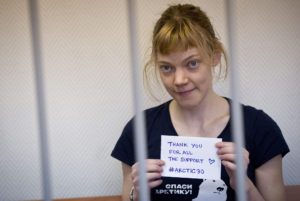In 2007, Greenpeace marine biologist John Hocevar was part of a team that took 22 dives into the Bering Sea’s Zhemchug and Pribiloff Canyons.
These underwater canyons are larger than the Grand Canyon (up to 60 miles wide and 9,000 feet deep) and teeming with undersea wildlife. Unfortunately, they’re often overfished with trawling nets and other unsustainable practices.
John and his colleagues also shot video. Recently, Chris Eaton and others at Greenpeace USA worked with the video and YouTube tools to create an innovative “create your own story” experience that allows viewers to take a self-guided trip through canyons, see some of the diverse marine life up close, and create a connection with this otherwise unknown and impossible to visit area.
The Bering Sea Canyons campaign rolled out in late-March. By optimizing sharing tools and strategic outreach, viewers will spread word of these places across their personal networks.

John Hocevar, Greenpeace marine biologist, boarding a submersible.
Challenge: Raise awareness of an unknown underwater place managed by a mysterious international committee
Overfishing, by-catch, bottom trawling and other damaging fishing practices are serious concerns in this remote region.
Marine life here has few champions. The North Pacific Fisheries Management Council is an international body with representatives from several nations that is largely made up of commercial fishing interests while operating relatively undisturbed by public oversight. It is difficult to generate pressure that can impact the Council’s decisions.
Recently, however, the Council announced that it will review possible protection for these deep sea canyons. Submarine captain (and marine biologist) John Hocevar pointed out that public comment is making an impact:
The Council member who introduced our motion spoke eloquently about the large numbers of people (close to 30,000) who had urged the Council to act, saying it gave them a mandate to do more than just request a review…the decision makers referred to the large numbers of comments they’d received as part of their justification for the position they took.
This step forward sets in motion a process that will review scientific data on fisheries management. Public awareness and support for protection may play a significant role and that’s where the submarine video becomes a player in this story.

Screenshot from the Bering Sea submarine build your own adventure story
Creative video to raise awareness
While piloting Deepworker submersibles in 2007, John and others found (for starters) 14 species of coral up to 1,000 feet deep as well as translucent apricot-colored juvenile king crab, sponges cradling fish eggs, orange and white tie-died anemones, a cluster of six king crabs crowding a lively rock covered in basket stars, spotted rockfish hugging pink sea-fan corals, and a spectacular magenta octopus curled up asleep among the sponges at 826 feet.
It’s difficult to persuade people to talk about (much less take action to protect) a place that they have not heard of and will never visit. The campaign team chose to use YouTube annotation tools to let the viewer create their own version of the story.

The result is a unique and potentially deeper experience for most every viewer – an event more likely to move viewers to understand and share the story. It is also a way of making more of the canyon accessible to more people.
The choose your own adventure launched in late-March, shortly before the North Pacific Fisheries Management Council announced that it would formally study protection of the Bering Sea canyons. This means that the video will play a potentially significant role in the protection campaign.
Chris Eaton, Greenpeace online lead for the campaign, talked with us about some of the goals and progress to date:
-
- Long term awareness building. The Bering Sea Canyons aren’t well known and, being thousands of feet below the ocean surface, aren’t easy to see in person (or even on a map). Building awareness and empathy is a challenge. Visual storytelling is a strong way to help move towards the cultural understanding needed to move people from curious to supportive.
- Experimenting with YouTube tools. We are using all of youtubes available tools (annotations, video responses, tags) to maximize user engagement. I’m hoping that deploying the full set of tools over a large number of videos will really increase viewership in the future.
- New audiences. A goal is to reach new audiences, particularly kids, parents and teachers. This is yet to pan out.
The best way to experience the submarine adventure is the visit the Bering Sea submarine adventure page. We’ve embedded the opening video below, though, and you can participate in your own story here.
Categories:
narrative, framing and storytelling

